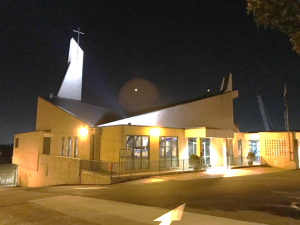It was a great pleasure and privilege to speak at the recent clergy conference of the Archdiocese of Sydney, held at the Liverpool Catholic Club on 25 October, 2017. Thank you to Archbishop Anthony Fisher OP, Bishop Randazzo, Bishop Umbers, Fr Paul Monkerud and Fr Kelvin Lovegrove for the generous invitation to share a few words on the nature of the ‘new evangelisation’ and ordained ministry within a changed landscape of faith.
A ‘Critical Moment’
 Amidst the unfussy pews of the parishes we know and love the grace of Christ continues to move and mould hearts to his own. The local parish, even in its ordinariness, remains a privileged location of God’s transforming grace in the world.
Amidst the unfussy pews of the parishes we know and love the grace of Christ continues to move and mould hearts to his own. The local parish, even in its ordinariness, remains a privileged location of God’s transforming grace in the world.
It is also a perennial insight of our Catholic tradition that we cannot grow as persons by holding the door closed against reality. This is also true of the parish.
In this respect I’d like to begin with a few observations on the current situation of the Australian parish before suggesting implications for our pastoral practice as communities of faith and, following, to consider the implications for the ministry of the ordained.
Researchers have described the Catholic parish as having reached a ‘critical moment’ in the life of the Australian Church (and here I am indebted to the work of the Pastoral Research Office).[1]
We know that of our 5.4 million Catholics in Australia only 662,000 or 12.2 per cent join us for Eucharist on any given weekend.[2] Almost a third of these Mass attenders (some 220,000) are aged between 60 and 74 years of age while of all Catholics aged between 20 and 34 in Australia, only 5-6% attend.[3] So what we are seeing is an ageing congregation in our pews with fewer among younger generations to replace them as we move into the future. Interestingly, Mass attendance peaks in Australia at around the age of 75, proving the rule that ‘the closer you get to God, the closer you get to God’!
Migrants, of course, account for over 40% of our Mass attenders.[4] We are indebted to and sustained by the participation of diverse ethnic communities. However, we also know that second generation Australians, that is, the children of Catholic migrants, are far less likely to practice than their parents. In total, some 13,000 Catholics stop attending Mass each year, and across all age groups more than 20,000 Australians every year are ceasing to identify themselves as Catholic at all (a dis-identification of some 100,000 Catholics over the last five years).[5]
The prospect that this situation raises in our lifetime is that of ongoing Catholic institutions – including schools, colleges, universities, hospitals, nursing homes and aged care facilities – but fewer parishes where the worship of God enjoins a community of believers.[6] The related concern is that the Church in Australia will be reduced to a form of non-government organisation, a provider of services – including healthcare and education – but whose religious dimension is associated more strongly with their historical origins rather than their existing or continuing spirit.
It becomes clear that we need our Catholic parishes to grow because they are integral and indispensable to our spiritual identity as a Church. Together with the family, the local parish remains a primary venue where faith is given shape and social support, fostered into discipleship and then enters the world. In all these ways, the future of the Australian Church relies on the vitality of the Catholic parish. Indeed, if we did not have parishes we would have to create them – local communities gathered around the Word and Eucharist.
A New Landscape for Faith
 As the mainstay of ecclesial life, the parish is, however, undergoing a process of undeniable change and has become an increasingly complex reality on account of a number of factors. Parishes are becoming geographically larger and yet numerically smaller with the practice of amalgamation and diminishing attendance. We experience growing multicultural diversity and new immigration in our pews and on the altar in our active clergy; we are impacted by a shortage and ageing of priests as we inevitably baptise more than we ordain; and we see the beginnings of more regional planning in the light of our resources and a desire for more creative ways of organising ourselves as Church.
As the mainstay of ecclesial life, the parish is, however, undergoing a process of undeniable change and has become an increasingly complex reality on account of a number of factors. Parishes are becoming geographically larger and yet numerically smaller with the practice of amalgamation and diminishing attendance. We experience growing multicultural diversity and new immigration in our pews and on the altar in our active clergy; we are impacted by a shortage and ageing of priests as we inevitably baptise more than we ordain; and we see the beginnings of more regional planning in the light of our resources and a desire for more creative ways of organising ourselves as Church.
On the level of faith, we know as well that we can no longer rely on a straightforward ‘conveyer belt’ which was presumed to take Catholics from the cradle to the grave in faith, the assumption that a Catholic baptism, having Catholic parents, mere attendance at a Catholic school or Catholic university, for example, would secure a lifetime of committed discipleship. Indeed in our pews, schools and agencies there is no ‘beige Catholicism’ or ‘cookie cutter Catholic’. Our experience tells us that we have in our communities people at various stages of faith, with varying relationships to the person and the message of the Gospel. Discipleship is never a given.
Our parishes are populated with the deeply committed, those who hold a vague or uncertain faith, those who affiliate out of family custom rather than conviction, and some engage with our Church for reasons other than religious motives (for the purpose of school enrolment for instance). As well our sharing of the same pews does not mean we believe the same things (for example, many older Catholics have stopped believing that pre-marital sex is always wrong, perhaps because many of their children are now cohabiting with their partners).[7]
Even among those most committed each Sunday there will be people at various stages of faith commitment, as Sherry Weddell notes in her decades’ long experience of discernment with laity and clergy. People find themselves passing through various thresholds of faith, in and out at times:
- Initial trust (positive association with Jesus Christ, the Church, a Christian believer)
- Curiosity (intrigued or initial desire to know more)
- Openness (acknowledges themselves open to personal and spiritual change)
- Spiritual seeking (move from being passive to actively seeking to know God)
- Intentional discipleship (‘dropping their nets’ with a conscious commitment to follow Christ in the midst of the Church).[8]
So it is an increasingly complex scene for parish mission today. As Ed Murrow, a broadcast journalist of last century, pointed out in the face of complexity, “Anyone who isn’t confused doesn’t really understand the situation”.
The Problematic
 The times have changed definitively. Some would say these times are not for us. However, and this is the pinch, while the surrounding culture and conditions of faith has changed our pastoral practice has remained much the same. I think it is for this reason that our efforts, our tireless and well-intended efforts, are not bearing the fruit of intentional and missionary discipleship we so desperately want to see. We are in a new landscape for faith but are still reading off the same maps. It is no wonder that people are lost along the way.
The times have changed definitively. Some would say these times are not for us. However, and this is the pinch, while the surrounding culture and conditions of faith has changed our pastoral practice has remained much the same. I think it is for this reason that our efforts, our tireless and well-intended efforts, are not bearing the fruit of intentional and missionary discipleship we so desperately want to see. We are in a new landscape for faith but are still reading off the same maps. It is no wonder that people are lost along the way.
Take one recent example, the increased number of Australians now identifying as ‘no religion’. For the first time in our history we have more ‘nones’ than Catholics in our nation, with ‘nones’ now accounting for 30.1% of the population while 22.6% of Australians self-identify as Catholic. There might have been once a hope that those who were baptised and guided to the faith in youth and who then drifted away might eventually return to the Church at a later age, perhaps when they had children of their own. This might have been the story for some baby boomers who, once emancipated from their parents, became a ‘seeker’ and explored other options, before coming home to the Catholic fold or settling in a new church. However, today the figures are not showing that kind of return to Christianity in general and Catholicism in particular. Disaffiliation is here to stay.
While scandal and poor experiences of Church and parish can be a part of this story, realistically some have shed the Catholic ‘brand’ as they have come to the plain and simple conclusion that their lives simply no longer reflect the religion they inherited. The result is many today feel comfortable in saying, ‘To be honest, I don’t belong anymore’.
In fact, a very basic analysis looking at ‘net’ changes between Censuses showed that between 2011 and 2016 every 5-year age group (from the age of 10 onwards) saw a net decrease of people identifying as Catholic, which was not the case in the five years prior. Catholics in almost all age groups are ceasing to nominate as such.
This shift challenges our parishes for, historically and habitually, our parish outreach programs are geared towards Mass attending Catholics or those still identifying as Catholic even if they are not practicing. We are not so comfortable reaching the ‘nones’ or secular people who do not attend or identify with us whatsoever. These ‘nones’ are not saying, ‘If only you had a better version of Church I would go to it’. They are not interested in ‘Church’ at all so our new coffee and contemporary Church music is not what they are looking for. It would be akin to trying to sell an upgraded car to someone who is not in the market for one. Evangelisation in this new time calls us to adjust our eyes and lengthen our arms to reach increasingly secular people where our relationships with them (rather than religious upgrades) will take priority.
Opportunities for Parish Renewal
 Looking forwards and taking into account the complexity and variety of this new situation, I would suggest three principles or areas for consideration in the effort to renew and strengthen the evangelising mission of the local parish.
Looking forwards and taking into account the complexity and variety of this new situation, I would suggest three principles or areas for consideration in the effort to renew and strengthen the evangelising mission of the local parish.
These three areas of focus include the need to take more seriously pre-evangelisation (what the Congregation for Clergy, describes as ‘Christian witness, dialogue and presence’ prior to proclamation), the recovery of discipleship as the fundamental basis of parish life and mission, and the setting of parish vision as essential to stimulating growth and motivating change.
Pre-evangelisation
An accessible way to underscore the critical importance of ‘pre-evangelisation’ (our witness, dialogue and presence in charity prior to any explicit proclamation of the Gospel) is to contrast it with a word and activity that we are more comfortable or familiar with as Catholics and that is ‘catechesis’. The word ‘catechesis’ means ‘to sound out’. It has been compared to standing at the entrance of a cave, and speaking out and hearing a voice coming back. When we catechise we are speaking into people’s lives, we are giving them faith and knowledge, and what we seek is for that faith and knowledge to resound back, echo back upon its reception. However, the only way we can hear an echo is if there is a ‘cave’, if there is a space to speak into. If we were to run out and shout at a brick wall we are not going to hear an echo as there is no space to absorb and reverberate what is being shared. This is why pre-evangelisation matters and must precede catechesis because there has to be an open space to speak into if we are going to hear faith resound back from one receiving the Gospel into their life.
In past attempts at evangelisation, we have not always been sufficiently attentive to where people are at in their lives and sought to convey the Gospel to them almost as a blunt tool without an appreciation of whom we are speaking, their lived situations and immediate concerns. These situations can be the ‘on ramp’ to the evangelisation, faith and conversion we want to see.
It could be added that past attempts at evangelisation have so often confused people’s indifference with ignorance. People’s hearts may not be engaged, they may be indifferent or hold little trust in the Church or ourselves as Christians, entertain little space or desire for dialogue, and yet we can seek to drown them in information in the hope that this might effect personal change. In short, we have sought to instruct the indifferent, catechise the unconcerned, and can, as Evangelii Gaudium notes, fall into the trap of providing answers to questions that nobody is asking (EG 155).
 While Pope Francis represents neither the first nor the last word in the Church’s grappling with mission, we cannot miss the moment. His clear emphasis on accompaniment as fundamental to change of life and conversion is right for our times. Reaching the ‘nones’ and even the ‘nominals’ invites such relationship, marked by tenderness, especially at a time when established institutions, above all the Church, are subject to a cultural distrust that deafens the wider community to our claims. In Evangelii Gaudium the Holy Father clarifies, “Genuine spiritual accompaniment always begins and flourishes in the context of service to the mission of evangelisation”[9]. “Spiritual accompaniment must lead others ever closer to God . . . to accompany them would be counterproductive if it became a sort of therapy supporting their self-absorption and ceased to be a pilgrimage with Christ to the Father”.[10] In short, we are called not to be chaplains of secular humanism but to prepare and equip our people for the kind of courage in faith demonstrated by St Paul in the Acts of the Apostles (Chapter 17:16-34).
While Pope Francis represents neither the first nor the last word in the Church’s grappling with mission, we cannot miss the moment. His clear emphasis on accompaniment as fundamental to change of life and conversion is right for our times. Reaching the ‘nones’ and even the ‘nominals’ invites such relationship, marked by tenderness, especially at a time when established institutions, above all the Church, are subject to a cultural distrust that deafens the wider community to our claims. In Evangelii Gaudium the Holy Father clarifies, “Genuine spiritual accompaniment always begins and flourishes in the context of service to the mission of evangelisation”[9]. “Spiritual accompaniment must lead others ever closer to God . . . to accompany them would be counterproductive if it became a sort of therapy supporting their self-absorption and ceased to be a pilgrimage with Christ to the Father”.[10] In short, we are called not to be chaplains of secular humanism but to prepare and equip our people for the kind of courage in faith demonstrated by St Paul in the Acts of the Apostles (Chapter 17:16-34).
In his apostolic enterprise, St Paul develops intentional relationships with the Gentiles who are utterly unfamiliar with the Christian revelation. He does so by:
- Desiring the good of the other and holding a deep concern for them (“he was distressed that the city was full of idols”). Without that desire not much is possible.
- He attends to the questions they are asking rather than providing uninvited answers (“May we know what this new teaching is that you are presenting? It sounds rather strange to us, so we would like to know what it means”)
- He identifies shared values (“Athenians, I see how extremely religious you are in every way”)
- In seeking to share the Gospel, he uses evidence and examples from the audience’s perspective (“As even some of your poets have said, ‘For we too are his offspring. Since we are God’s offspring, we ought not to think that the deity is like gold’)
- He avoids using ‘insider’ language so as not to create stumbling blocks too early in the relationship (e.g. he does not yet use the name of Jesus though he will go on to do so).
- He begins to inspire curiosity, rather than providing pat answers (“When they heard of the resurrection of the dead, some scoffed; but others said, ‘We will hear you again about this’”)
- Ultimately some became believers, “including Dionysius the Areopagite and a woman named Damaris, and others with them”.
Our own age also suggests a shift from thinking about evangelisation in terms of programs and showcase events to processes that accompany people to personal and spiritual change. This brings us to a second and related opportunity – the recovery of discipleship as the primary purpose of our parishes.
Reclaiming Discipleship
A focus on discipleship reclaims the Great Commission of Matthew’s Gospel as the foundational task of the church Catholic and of the parish as its local manifestation: “Go therefore and make disciples of all nations, baptising them in the name of the Father and of the Son and of the Holy Spirit, and teaching them to obey everything that I have commanded you” (Matt. 28:19). As it has been pointed out, our Catholic Church has certainly learnt to “go” and can claim a presence at all corners of the earth. We “baptise” and confirm relentlessly. We “teach” and catechise great numbers in our Australian schools and sacramental programs. However, our ability as Church to “make disciples” remains in question, as raised by the pastoral realities for the Australian Church we have explored.[11]
 We must acknowledge that if we were to measure how many of those hundreds who receive the sacraments in our local parish each year, pass through our sacramental life in initiation or from week to week, and emerge on the other side as ‘missionary disciples’, we would have to admit that there is much less fruit than we might hope to see. Our pastoral experience tells us that we have in our communities no lack of those who have been ‘sacramentalised’ but not yet evangelised, those who are merely ‘done’ but not yet discipled.
We must acknowledge that if we were to measure how many of those hundreds who receive the sacraments in our local parish each year, pass through our sacramental life in initiation or from week to week, and emerge on the other side as ‘missionary disciples’, we would have to admit that there is much less fruit than we might hope to see. Our pastoral experience tells us that we have in our communities no lack of those who have been ‘sacramentalised’ but not yet evangelised, those who are merely ‘done’ but not yet discipled.
I would suggest that one of the causes of our dilemma as Church is that we have tended to lift the sacraments, and indeed much else that the Church does, out of their proper context which is precisely discipleship, a living and fruitful faith. A pastoral approach that assumes the sacraments will simply ‘take care of it’ neglects our duty to awaken in each person that active and personal faith, that fertile soil, in which the grace of the sacraments can actually take root and bear fruit. To make the point,
baptisms, confessions, weddings, funerals, daily devotions, anointing, and adoration. It’s all good stuff, it’s how some Catholics grow spiritually. For others, it’s what they do instead of grow . . . For certain, the sacraments give us grace to put us in right relationship to God and his life in our soul, nourishing and strengthening us for our discipleship walk. But they’re not mean to replace it.[12]
This is not to discount the centrality of the sacraments or to deny the place that devotions have in the Catholic life. But it is to say that people can be ‘sacramentalised’ without being evangelised, that it is entirely possible to undertake a routine of religious custom and practice without a personal and responsive relationship to Jesus Christ.
In short, we cannot look at the sacraments or our pastoral practices in isolation from discipleship. Unless people come to faith, come to relationship with God, unless people become disciples, the likelihood that the sacraments will bear the fruit they are intended to bear is severely diminished. As the saying goes, gifts are given but fruits are grown.
To substantiate this view in tradition, Vatican II’s Sacrosanctum Concilium affirms that the sacraments presume a living faith amidst its people.[13] The Catechism of the Catholic Church which followed tells us explicitly, “The sacred liturgy does not exhaust the entire activity of the Church: it must be preceded by evangelisation, faith, and conversion”.[14] As well, both the Council and the Catechism affirm the Eucharist as “the source and summit of the Christian life“.[15] When there is no Christian life, no trace or intention of Christian living, then the Eucharist can be neither source nor summit of anything (it remains so in fact but not in effect). Outside of the context of discipleship, the Eucharist can be reduced to an object of piety or mere consumption rather than a relationship that invites a Jesus-shaped life. We could say that the mission of the Church is not sacraments but disciples which the sacraments nourish.
Passive reception of a sacrament is not enough as the Catechism names without apology: “To attribute the efficacy of prayers or of sacramental signs to their mere external performance, apart from the interior dispositions that they demand, is to fall into superstition”.[16] In other words, sacraments are not magic. The Church has consistently taught that a positive disposition is critical to the reception of grace. As St Augustine avers, God ‘did not will to save us without us’. Living faith is essential if the grace of the sacraments is not to be bound – merely valid but tied – within the life of the one who receives.
 At the level of the parish, this gap between our presumptions (our unspoken ‘sacramentalism’ that assumes the sacraments will simply ‘take care of it’) and the active faith and discipleship to which all the baptised are called is palpable. Time and again how often have we heard parents, good and faithful parents, lament that their grown children are now disconnected from the Church, that they are no longer going to Mass, and even now hold no faith at all. Yet they did all they were supposed to do, received all their sacraments, and their children served as altar servers and so on. There can also be a latent notion, and I think a false hope, that the grace of the sacraments might ‘kick in’ many years later, like a time release capsule, but there is very little evidence that this is true. Again, hear the laments of old generations of Catholics who did all they thought they had to do, received all the sacraments, were never encouraged to ask questions and carried out the practice of the Catholic religion but lament never experiencing a life-giving or transforming faith. Where is the fruit?
At the level of the parish, this gap between our presumptions (our unspoken ‘sacramentalism’ that assumes the sacraments will simply ‘take care of it’) and the active faith and discipleship to which all the baptised are called is palpable. Time and again how often have we heard parents, good and faithful parents, lament that their grown children are now disconnected from the Church, that they are no longer going to Mass, and even now hold no faith at all. Yet they did all they were supposed to do, received all their sacraments, and their children served as altar servers and so on. There can also be a latent notion, and I think a false hope, that the grace of the sacraments might ‘kick in’ many years later, like a time release capsule, but there is very little evidence that this is true. Again, hear the laments of old generations of Catholics who did all they thought they had to do, received all the sacraments, were never encouraged to ask questions and carried out the practice of the Catholic religion but lament never experiencing a life-giving or transforming faith. Where is the fruit?
As an aside, we have traditionally been more focused on issues of validity – and validity of the minister’s celebration of the sacrament, tied up with the controversies of the Donatists and Reformation – rather than its fruitfulness. This is despite the biblical mandate of John 15:6 and magisterial teaching such as that of St John Paul II who remarked, and I quote, “Bearing fruit is an essential demand of life in Christ and life in the Church. The person who does not bear fruit does not remain in communion: ‘Each branch of mine that bears no fruit, he (my Father) takes away”. Without fruit, without active discipleship, there is no communion, only a crowd.[17]
To ground our discussion in practice, what would it look like if the commission to make disciples informed our sacramental preparation, moving away from what is generally an age-based reward system for many who will never darken the doors of our parishes again? Certainly we must commit to meeting people ‘where they are’ but we also have to love them enough not to leave them there. Pastoral care and accompaniment are not opposed to personal challenge and the expectation of spiritual growth. Pastoral care and accompaniment are fulfilled by the change of life that discipleship entails.
For the priest, this involves helping people understand what holiness requires as a teacher and helping them to realise this teaching in practice as a pastor. As such our first response to the mixed assembly of people who come forwards for the sacraments of initiation should never be a ‘no’ but at times the proper response in good faith could well be a ‘not yet’. ‘No’ should not be our first response but time may be needed to reflect on what a ‘yes’ means and to allow people to be prepared not simply for one sacrament or one liturgy but for a lifetime of discipleship.
 As an attempt to set discipleship at the heart of my home parish of St Bernadette’s Parish, Castle Hill, we introduced four weeks of parental preparation for entry into the sacramental program (the parish celebrated the sacraments of Reconciliation, Confirmation and Eucharist all in the one nine month period). This formation was focused not on children but on parents who were asked to attend four 2 hour sessions – on God and us, God and his Church, God and the sacraments, and living God’s way. Each session was offered three times a week to accommodate parents’ commitments, and completion of all four sessions was a requirement of entry into the sacramental program and preparation for the year.
As an attempt to set discipleship at the heart of my home parish of St Bernadette’s Parish, Castle Hill, we introduced four weeks of parental preparation for entry into the sacramental program (the parish celebrated the sacraments of Reconciliation, Confirmation and Eucharist all in the one nine month period). This formation was focused not on children but on parents who were asked to attend four 2 hour sessions – on God and us, God and his Church, God and the sacraments, and living God’s way. Each session was offered three times a week to accommodate parents’ commitments, and completion of all four sessions was a requirement of entry into the sacramental program and preparation for the year.
Of course, in raising this expectation, focused as it was on parents, some did not take to this requirement and looked elsewhere for easier admission to the sacraments which the parishes next door were only too happy to provide. However, while some people walked away, it always has to be questioned if this is ever a real loss, for people to lament or kickback, saying in effect, ‘Well we’re going to go to another parish that we won’t go to’. It may well be that the neighbouring parishes accommodated more people in their sacramental program but none of these saw an increase in weekly attendance, more people living faith in the midst of the community, and only increased their administrative workload all the while being disconnected from the living discipleship which is our real and primary purpose.
Recall in respect of the sacraments that the Great Commission calls us to ‘go make disciples’ and then baptise and teach. In many ways, we are running our attempts at evangelisation in reverse order to the ancient Church. In the ancient Church, neophytes were evangelised, catechised, initiated and then given access to the sacred mysteries, namely the liturgy of the Eucharist. Today neophytes are introduced to the liturgical rites, initiated, and then those who remain in the pews may be lucky enough to be catechised, and perhaps a handful might come to be evangelised.
To grow our parishes we must reclaim discipleship as the ‘new norm’ and a starting point for evangelisation. We must recognise that the measure of parish vitality is not the number of ‘bums on seats’ but a matter of impact, the extent of personal and spiritual change the Spirit brings about through the environment and processes we install to support an encounter with Christ. To underscore our goal is discipleship and not mere scale, the Church was never more ‘catholic’ than in the Upper Room at Pentecost when all of its members could fit inside a tiny room. ‘Good church’ does not necessarily mean a large church, and faithfulness and fruitfulness is not measured in the size of a crowd. Large parishes can be spiritually dead, and small parishes can foster genuine discipleship like no other.
A missionary parish will be a parish dedicated to discipleship, raising up through welcome and expectation men, women and families who:
- enter into a personal relationship with Jesus
- can and do share faith with others
- are open to the gifts of the Holy Spirit
- have knowledge and love of the Scriptures
- know basic Catholic theology
- have a daily prayer life
- experience real Christian community
- have a commitment to Sunday Eucharist
- celebrate the Sacrament of Reconciliation
- can pray spontaneously out loud when asked (this in fact presumes the practice of personal, daily prayer as aforementioned)
- serve in ministry,
- and see their lives as a mission field.[18]
This is the quality of Christian living we seek to bring about in God’s Church. This is the commission of discipleship that Jesus entrusts to his apostles.
Parish Vision
 We turn now to consider how we might move our communities from a casual acceptance of sacramental minimalism to the apostolic zeal of an evangelising parish. A third key opportunity to move from maintenance to mission is the development of an articulate vision that goads, challenges and stimulates the parish toward change. Our parishes are often caught between a call and desire for renewal and the weight of our own church culture towards maintaining the status quo. In this moment which cries out for new energies, priests and people alike can feel bound by layers of expectation that demand the continuation of the old even while new forms of life and mission long for expression.[19]
We turn now to consider how we might move our communities from a casual acceptance of sacramental minimalism to the apostolic zeal of an evangelising parish. A third key opportunity to move from maintenance to mission is the development of an articulate vision that goads, challenges and stimulates the parish toward change. Our parishes are often caught between a call and desire for renewal and the weight of our own church culture towards maintaining the status quo. In this moment which cries out for new energies, priests and people alike can feel bound by layers of expectation that demand the continuation of the old even while new forms of life and mission long for expression.[19]
However, a fresh vision admits of new possibilities and allows us to let go of what no longer serves our mission. When we communicate a vision for the parish, how we seek to respond to God in this context, in this time, in this local community, when we can articulate a vision of the kinds of spiritual growth we are seeking to raise up in our people, this passionate purpose becomes the heartbeat or pulse of a parish. As in our Eucharistic liturgies, ‘remembrance of our future’ in Christ provides the case for change and conversion in the present.
The alternative to a parish communicating vision is a community standing in the silence of an unquestioned routine. The lifeblood of the parish might occasionally receive a boost or uptick through the initiative of individuals or the occasional event but without a sustained vision to consistently stimulate a higher life, the pulse of the parish inevitably slows and returns to maintenance, to the pace of survival rather than growth.
Not only is a clear and galvanising vision the basis of every growing Christian community that I am aware of, whether Catholic or otherwise, it is clear that our people are hungry and seeking this clarity of purpose and direction. The recent 2016 NCLS survey tells us that around 30% of Mass attending Catholics are unaware of any vision, goal or direction in their local parish, while 18% of parishioners (including those in parishes of the Archdiocese) want to be more involved.[20] It is our task as leaders to answer the question, “Involvement in what?”
A parish vision that reclaims the Great Commission, that reclaims the making of disciples as our primary calling clarifies the purpose of the community and makes it possible for others to become a part of that purpose. It is not a stretch to assert that some of the spiritual stagnation in our pews may be attributable to the plain fact that many Catholics have no vision at all as to how the life of holiness could be pursued or ultimately take expression.
As an example, a sense of welcome and expectation is well captured in the vision of Saint Benedict Parish in Halifax, Nova Scotia, “Saint Benedict Parish is a healthy and growing faith community that brings people to Christ, forms disciples, and sends them out to transform the world. Our members commit to worship, to grow, to serve, to connect and to give”. This combines welcome and expectation, as Jesus does in John’s Gospel when he expects the vine to bear fruit, and even prunes and expects more from those vines already producing.[21] It underscores that healthy things grow and sets the expectation of growth for its members. If we do not cast such vision for our people in our Church, the question will inevitably arise from the pews, ‘Are we going anywhere?’
As Sherry Weddell notes with conviction, parishes that seriously and consistently set a vision for and make disciples will experience astonishing levels of growth in depth and number,
Disciples are hungry to pray and worship, so naturally Mass attendance goes up. Disciples want to serve, and often migrate into parish leadership. Disciples will fill every faith formation class in your parish and diocese, because they want to grow in their faith. They clamour to discern personal vocation and personal call . . . Disciples go to great lengths to pass on the faith to their children. They care about the poor and about justice. They take risks for the kingdom of God. Disciples give.[22]
As we will note, the teaching, liturgical and pastoral offices of the priest is in service of this process of evangelisation in which disciples are formed and sent into service of the Kingdom, that fullness of life in God, that Jesus himself embodies.
Conclusion
We have surveyed the state of the Australian parish, named the complexity of our local faith communities amidst a new landscape for faith. We have addressed the necessity of pre-evangelisation in the journey of faith, contrasting it with catechesis that has assumed a reality that is no more, and underlined discipleship as the context or lens through which to reclaim the evangelising mission of the parish, as the context for our sacramental life, our ministry and mission in the world. Finally, we have canvassed vision as critical to the revitalisation of the Church communities for mission, setting forth a definite purpose for our local communities with which people can engage.
Each of these elements contains implications for the ordained which we will enter into after our break. Whatever vocation we inhabit, as the baptised a reinvigorated mission ultimately means responding and having trust in what Christ in the Holy Spirit can do for us, with us and through us, even in the well-worn pews of the parishes we know and love.
References:
[1] Robert Dixon, Stephen Reid and Marilyn Chee, Mass Attendance in Australia: A Critical Moment. A Report Based on the National Count of Attendance, the National Church Life Survey and the Australian Census (Melbourne: ACBC Pastoral Research Office, 2013), 8.
[2] Ibid., 1.
[3] Ibid., 2-3.
[4] Pastoral Research Office E-News Bulletin, ‘Issue 18: Who goes to Mass? – First results from the 2011 NCLS – 2 December 2012’. Available online at http://www.pro.catholic.org.au/pdf/ACBC%20PRO%20E-News%20Bulletin%2018.pdf. Accessed 4 August, 2014.
[5] Dixon, Reid and Chee, Mass Attendance in Australia: A Critical Moment, 4; Robert Dixon and Stephen Reid, ‘The Contemporary Catholic Community: A View from the 2011 Census’, Australasian Catholic Record 90/2 (2013): 144-146.
[6] Robert Dixon, ‘The Catholic Community in Australia: Context and Challenges’, Presentation at the Pastoral Research Office Conference: ‘Beliefs and Practices of Australian Catholics’, 20 February, 2014.
[7] Robert Dixon, “What do Mass attenders believe? Contemporary cultural change and the acceptance of key Catholic beliefs and moral teachings by Australian Mass attenders” (Pastoral Research Office, February 2014), 8.
[8] Sherry Weddell, Forming International Disciples (Huntington, Indiana: Our Sunday Visitor, 2012), 125-184.
[9] Pope Francis, Evangelii Gaudium 173.
[10] Ibid; 170.
[11] Fr James Mallon, Divine Renovation: Bringing Your Parish from Maintenance to Mission (New London, CT: Twenty-Third Publications, 2014), 19-20.
[12] Fr Michael White and Tom Corcoran, Rebuilt: The Story of a Catholic Parish (Notre Dame, Indiana: Ave Maria Press), 77.
[13] Vatican II, Sacrosanctum Concilium 59.
[14]Catechism of the Catholic Church #1072.
[15]Catechism of the Catholic Church #1324.
[16]Catechism of the Catholic Church #2111.
[17] John Paul II, Christifideles Laici 32. ‘Validity’ means that the sacrament was truly bestowed and the intended grace made truly present to the person receiving the sacrament. But validity does not guarantee that the grace made available has been actively received and is bearing fruit in that person’s life. See also Weddell, Forming Intentional Disciples, 99-123.
[18] Fr James Mallon, Divine Renovation Guidebook (Toronto, Ontario: Novalis Publishing, 2016), 59.
[19] Mallon, Divine Renovation, 53.
[20] NCLS Research, Church Life Profile for the Catholic Church in Australia: A Report on Vitality of Local Churches who took part in the 2016 National Church Life Survey (North Sydney, 2017), 10.
[21] Cf. John 15:1-2; Mallon, Divine Renovation, 155.
[22] Sherry Weddell, “Discipleship: The Key to Fruitfulness”, Chicago Studies 54:2 (Fall 2014): 24.
 I was grateful to be part of a workshop this week hosted by the Australian Catholic Youth Council in North Sydney. It drew together a select group of parish and diocesan youth leaders in conversation with Australia’s delegates for the October Synod on youth, Archbishop Anthony Fisher OP and Bishop Mark Edwards OMI, as well as Archbishop Comensoli.
I was grateful to be part of a workshop this week hosted by the Australian Catholic Youth Council in North Sydney. It drew together a select group of parish and diocesan youth leaders in conversation with Australia’s delegates for the October Synod on youth, Archbishop Anthony Fisher OP and Bishop Mark Edwards OMI, as well as Archbishop Comensoli. As the Church in Australia considers its future, it is imperative to understand the interactions and experiences that comprise young people’s lives for these provide the building blocks for renewed mission with and to young people. While the Catholic faith may today occupy less surface space in Australian culture, the rise of dedicated disciples within promises to bring new depths to our Christian living and cultural impact, and encourage the whole Church in its mission to the concrete people of each generation.
As the Church in Australia considers its future, it is imperative to understand the interactions and experiences that comprise young people’s lives for these provide the building blocks for renewed mission with and to young people. While the Catholic faith may today occupy less surface space in Australian culture, the rise of dedicated disciples within promises to bring new depths to our Christian living and cultural impact, and encourage the whole Church in its mission to the concrete people of each generation. Challengingly, among Australian Catholic youth the influence of Church or religious leaders in their key decisions and directions is thin, identified as significant by just 11% of those surveyed and aged between 16-18 years. This meek influence might be explained by a lack of personal relationship amongst some clergy and young people, the broader collapse of the Church’s credibility in the light of the sexual abuse crisis, and the real struggle of Church leaders to listen or ‘hold’ the questions that young people are asking of the Church. On this score, young Australian Catholics rated their experience of being listened at a modest 5.9 out of 10.[2]
Challengingly, among Australian Catholic youth the influence of Church or religious leaders in their key decisions and directions is thin, identified as significant by just 11% of those surveyed and aged between 16-18 years. This meek influence might be explained by a lack of personal relationship amongst some clergy and young people, the broader collapse of the Church’s credibility in the light of the sexual abuse crisis, and the real struggle of Church leaders to listen or ‘hold’ the questions that young people are asking of the Church. On this score, young Australian Catholics rated their experience of being listened at a modest 5.9 out of 10.[2] Positively, when Australian youth were asked how the Church can be of help to them, the responses actively invited our communities to provide guidance, to assist and counsel young people in their anxieties, personal challenges, understanding of sexuality and relationship issues.[6] As the meaning and direction of life is not uncovered in a single moment, it is incumbent upon the Church to journey with young lives in realising their own dignity and personal mission, both of which express a fundamental call to holiness.
Positively, when Australian youth were asked how the Church can be of help to them, the responses actively invited our communities to provide guidance, to assist and counsel young people in their anxieties, personal challenges, understanding of sexuality and relationship issues.[6] As the meaning and direction of life is not uncovered in a single moment, it is incumbent upon the Church to journey with young lives in realising their own dignity and personal mission, both of which express a fundamental call to holiness. Frustratingly for many, the accompaniment urgently desired by young Australian Catholics and urged by Pope Francis cannot be found neatly contained within a package or program. It demands in fact an entire culture of ecclesial life in which discernment is a norm and in regular evidence. When genuine discernment is not practiced in our sacramental programs, leading to fruitless reception, when RCIA processes teach people about Catholicism but neglect to train them to live as disciples, when parish pastoral councils and parish groups are more focused on ‘who will do it?’ rather than ‘where are we going?’, the offer of accompaniment to young people will appear more like false advertising than the expression of a community fully open to what God wants for the Church. The preparatory document for the Synod minces no words, “We cannot expect our offer of pastoral accompaniment towards vocational discernment to be credible to young people, unless we show that we are able to practice discernment in the ordinary life of the Church”.[1]
Frustratingly for many, the accompaniment urgently desired by young Australian Catholics and urged by Pope Francis cannot be found neatly contained within a package or program. It demands in fact an entire culture of ecclesial life in which discernment is a norm and in regular evidence. When genuine discernment is not practiced in our sacramental programs, leading to fruitless reception, when RCIA processes teach people about Catholicism but neglect to train them to live as disciples, when parish pastoral councils and parish groups are more focused on ‘who will do it?’ rather than ‘where are we going?’, the offer of accompaniment to young people will appear more like false advertising than the expression of a community fully open to what God wants for the Church. The preparatory document for the Synod minces no words, “We cannot expect our offer of pastoral accompaniment towards vocational discernment to be credible to young people, unless we show that we are able to practice discernment in the ordinary life of the Church”.[1]
 Amidst the unfussy pews of the parishes we know and love the grace of Christ continues to move and mould hearts to his own. The local parish, even in its ordinariness, remains a privileged location of God’s transforming grace in the world.
Amidst the unfussy pews of the parishes we know and love the grace of Christ continues to move and mould hearts to his own. The local parish, even in its ordinariness, remains a privileged location of God’s transforming grace in the world. As the mainstay of ecclesial life, the parish is, however, undergoing a process of undeniable change and has become an increasingly complex reality on account of a number of factors. Parishes are becoming geographically larger and yet numerically smaller with the practice of amalgamation and diminishing attendance. We experience growing multicultural diversity and new immigration in our pews and on the altar in our active clergy; we are impacted by a shortage and ageing of priests as we inevitably baptise more than we ordain; and we see the beginnings of more regional planning in the light of our resources and a desire for more creative ways of organising ourselves as Church.
As the mainstay of ecclesial life, the parish is, however, undergoing a process of undeniable change and has become an increasingly complex reality on account of a number of factors. Parishes are becoming geographically larger and yet numerically smaller with the practice of amalgamation and diminishing attendance. We experience growing multicultural diversity and new immigration in our pews and on the altar in our active clergy; we are impacted by a shortage and ageing of priests as we inevitably baptise more than we ordain; and we see the beginnings of more regional planning in the light of our resources and a desire for more creative ways of organising ourselves as Church. The times have changed definitively. Some would say these times are not for us. However, and this is the pinch, while the surrounding culture and conditions of faith has changed our pastoral practice has remained much the same. I think it is for this reason that our efforts, our tireless and well-intended efforts, are not bearing the fruit of intentional and missionary discipleship we so desperately want to see. We are in a new landscape for faith but are still reading off the same maps. It is no wonder that people are lost along the way.
The times have changed definitively. Some would say these times are not for us. However, and this is the pinch, while the surrounding culture and conditions of faith has changed our pastoral practice has remained much the same. I think it is for this reason that our efforts, our tireless and well-intended efforts, are not bearing the fruit of intentional and missionary discipleship we so desperately want to see. We are in a new landscape for faith but are still reading off the same maps. It is no wonder that people are lost along the way. Looking forwards and taking into account the complexity and variety of this new situation, I would suggest three principles or areas for consideration in the effort to renew and strengthen the evangelising mission of the local parish.
Looking forwards and taking into account the complexity and variety of this new situation, I would suggest three principles or areas for consideration in the effort to renew and strengthen the evangelising mission of the local parish. We must acknowledge that if we were to measure how many of those hundreds who receive the sacraments in our local parish each year, pass through our sacramental life in initiation or from week to week, and emerge on the other side as ‘missionary disciples’, we would have to admit that there is much less fruit than we might hope to see. Our pastoral experience tells us that we have in our communities no lack of those who have been ‘sacramentalised’ but not yet evangelised, those who are merely ‘done’ but not yet discipled.
We must acknowledge that if we were to measure how many of those hundreds who receive the sacraments in our local parish each year, pass through our sacramental life in initiation or from week to week, and emerge on the other side as ‘missionary disciples’, we would have to admit that there is much less fruit than we might hope to see. Our pastoral experience tells us that we have in our communities no lack of those who have been ‘sacramentalised’ but not yet evangelised, those who are merely ‘done’ but not yet discipled. At the level of the parish, this gap between our presumptions (our unspoken ‘sacramentalism’ that assumes the sacraments will simply ‘take care of it’) and the active faith and discipleship to which all the baptised are called is palpable. Time and again how often have we heard parents, good and faithful parents, lament that their grown children are now disconnected from the Church, that they are no longer going to Mass, and even now hold no faith at all. Yet they did all they were supposed to do, received all their sacraments, and their children served as altar servers and so on. There can also be a latent notion, and I think a false hope, that the grace of the sacraments might ‘kick in’ many years later, like a time release capsule, but there is very little evidence that this is true. Again, hear the laments of old generations of Catholics who did all they thought they had to do, received all the sacraments, were never encouraged to ask questions and carried out the practice of the Catholic religion but lament never experiencing a life-giving or transforming faith. Where is the fruit?
At the level of the parish, this gap between our presumptions (our unspoken ‘sacramentalism’ that assumes the sacraments will simply ‘take care of it’) and the active faith and discipleship to which all the baptised are called is palpable. Time and again how often have we heard parents, good and faithful parents, lament that their grown children are now disconnected from the Church, that they are no longer going to Mass, and even now hold no faith at all. Yet they did all they were supposed to do, received all their sacraments, and their children served as altar servers and so on. There can also be a latent notion, and I think a false hope, that the grace of the sacraments might ‘kick in’ many years later, like a time release capsule, but there is very little evidence that this is true. Again, hear the laments of old generations of Catholics who did all they thought they had to do, received all the sacraments, were never encouraged to ask questions and carried out the practice of the Catholic religion but lament never experiencing a life-giving or transforming faith. Where is the fruit? As an attempt to set discipleship at the heart of my home parish of St Bernadette’s Parish, Castle Hill, we introduced four weeks of parental preparation for entry into the sacramental program (the parish celebrated the sacraments of Reconciliation, Confirmation and Eucharist all in the one nine month period). This formation was focused not on children but on parents who were asked to attend four 2 hour sessions – on God and us, God and his Church, God and the sacraments, and living God’s way. Each session was offered three times a week to accommodate parents’ commitments, and completion of all four sessions was a requirement of entry into the sacramental program and preparation for the year.
As an attempt to set discipleship at the heart of my home parish of St Bernadette’s Parish, Castle Hill, we introduced four weeks of parental preparation for entry into the sacramental program (the parish celebrated the sacraments of Reconciliation, Confirmation and Eucharist all in the one nine month period). This formation was focused not on children but on parents who were asked to attend four 2 hour sessions – on God and us, God and his Church, God and the sacraments, and living God’s way. Each session was offered three times a week to accommodate parents’ commitments, and completion of all four sessions was a requirement of entry into the sacramental program and preparation for the year. We turn now to consider how we might move our communities from a casual acceptance of sacramental minimalism to the apostolic zeal of an evangelising parish. A third key opportunity to move from maintenance to mission is the development of an articulate vision that goads, challenges and stimulates the parish toward change. Our parishes are often caught between a call and desire for renewal and the weight of our own church culture towards maintaining the status quo. In this moment which cries out for new energies, priests and people alike can feel bound by layers of expectation that demand the continuation of the old even while new forms of life and mission long for expression.
We turn now to consider how we might move our communities from a casual acceptance of sacramental minimalism to the apostolic zeal of an evangelising parish. A third key opportunity to move from maintenance to mission is the development of an articulate vision that goads, challenges and stimulates the parish toward change. Our parishes are often caught between a call and desire for renewal and the weight of our own church culture towards maintaining the status quo. In this moment which cries out for new energies, priests and people alike can feel bound by layers of expectation that demand the continuation of the old even while new forms of life and mission long for expression. We find a few scant references to accompaniment in Pope Francis’ exhortation on marriage and family Amoris Laetitia, especially in relation to those in the early years of marriage and those who have experienced relationship breakdown or divorce (AL 223, 241-244). The concept is most fully elaborated, however, in Pope Francis’ first Apostolic Exhortation Evangelii Gaudium (‘The Joy of the Gospel’) where we find four articles dedicated to what he describes as the “art of accompaniment” (EG 169-173). These references are in the third chapter of the Exhortation, under the fourth section entitled “Evangelization and the deeper understanding of the kerygma”.
We find a few scant references to accompaniment in Pope Francis’ exhortation on marriage and family Amoris Laetitia, especially in relation to those in the early years of marriage and those who have experienced relationship breakdown or divorce (AL 223, 241-244). The concept is most fully elaborated, however, in Pope Francis’ first Apostolic Exhortation Evangelii Gaudium (‘The Joy of the Gospel’) where we find four articles dedicated to what he describes as the “art of accompaniment” (EG 169-173). These references are in the third chapter of the Exhortation, under the fourth section entitled “Evangelization and the deeper understanding of the kerygma”. Pope Francis has commented that we in the twenty-first century live not simply in an ‘age of change’ but in a ‘change of age’. He sees, as we do, the shifting ground of global politics, the movements of people around the world, including a disastrous refugee crisis, and the changing nature of how people communicate and relate to one another (to make the point, each day the equivalent of 110 years of live content is watched online while development such as OTT apps have essentially turned messaging services into a new form of communications infrastructure).
Pope Francis has commented that we in the twenty-first century live not simply in an ‘age of change’ but in a ‘change of age’. He sees, as we do, the shifting ground of global politics, the movements of people around the world, including a disastrous refugee crisis, and the changing nature of how people communicate and relate to one another (to make the point, each day the equivalent of 110 years of live content is watched online while development such as OTT apps have essentially turned messaging services into a new form of communications infrastructure). Moving from those who no longer engage with us to those who are still present in our churches, there is no longer a ‘cookie cutter Catholic profile’ if there ever was one. Many of the only-affiliated Catholics can be found in our sacramental programs. Many self-identifying Catholics do not believe in God at all but send their children to our Catholic schools in any case, and many more would pick and mix among various traditions – Eastern meditation over here, the occasional Easter Vigil over there.
Moving from those who no longer engage with us to those who are still present in our churches, there is no longer a ‘cookie cutter Catholic profile’ if there ever was one. Many of the only-affiliated Catholics can be found in our sacramental programs. Many self-identifying Catholics do not believe in God at all but send their children to our Catholic schools in any case, and many more would pick and mix among various traditions – Eastern meditation over here, the occasional Easter Vigil over there. What is the upshot of this complexity for our outreach and accompaniment? Prior to any proclamation of the Church being heard, today’s missionary outlook will begin with building trust and authentic personal relationships (from which consequent invitations and participation might then come about).
What is the upshot of this complexity for our outreach and accompaniment? Prior to any proclamation of the Church being heard, today’s missionary outlook will begin with building trust and authentic personal relationships (from which consequent invitations and participation might then come about). To make this opportunity concrete and practical, the outreach of St Paul, perhaps the greatest evangeliser in the history of the Church after Jesus himself, can be a resource for our thinking on this ‘art of accompaniment’.
To make this opportunity concrete and practical, the outreach of St Paul, perhaps the greatest evangeliser in the history of the Church after Jesus himself, can be a resource for our thinking on this ‘art of accompaniment’. When we consider how many people receive the sacraments in our Church, whether the sacraments of initiation or each weekend, and how many come out the other side as disciples on mission sharing faith with others, we can see the need for accompaniment to support that journey. We have learnt that the sacraments simply won’t ‘take care of it’, that discipleship needs the support of relationships via a process such as Alpha that builds trust and encourages sharing in faith.
When we consider how many people receive the sacraments in our Church, whether the sacraments of initiation or each weekend, and how many come out the other side as disciples on mission sharing faith with others, we can see the need for accompaniment to support that journey. We have learnt that the sacraments simply won’t ‘take care of it’, that discipleship needs the support of relationships via a process such as Alpha that builds trust and encourages sharing in faith.

































